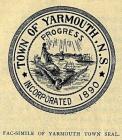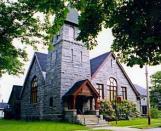7
In 1785 another group of Americans came to our area. These Loyalists preferred to stay loyal to the British crown rather than join the new United States of America. Over 10,000 people went to Shelburne, Nova Scotia in 1783 although most did not stay there long. In 1785 twenty-five Loyalists families left Shelburne and came to Tusket, a village approximately 10 miles from Yarmouth. Two subgroups of the Loyalists were the Black Loyalists (some of whom came as slaves and some who were free men) and soldiers who had fought for the British in the American Revolution. Some of the soldiers were British, others, such as the Hessians, were mercenaries and still others came from Jamaica.8
The largest group to settle the immediate area around Yarmouth was the New England Planters. Whereas the Planters who settled the Annapolis Valley turned to the soil for a living those in Yarmouth turned to the sea for their livelihood. This was partly because of the rocky nature of the land and partly due to the abundance of fish. Not only could the settlers fish but they could use the ocean as a highway to transport their catches. The forest nearby provided lumber to allow them to build their own vessels.From these small vessels Yarmouth shipbuilders and businessmen developed fleets of large ocean-going sailing vessels in the mid- to late-1800's. (See Story # 2 for a brief history of Yarmouth's shipping industry.)
10
The 1870's and 80's were times of great prosperity and growth for Yarmouth. Ambitious public buildings such as churches and schools were built while industries and businesses bloomed. Cultural life and recreation were not forgotten; there were literary societies, musical and theatrical groups, and sports organizations.As the sailing vessel bowed out to the steamers, Yarmouth businessmen reinvested their money. A major industry was established in the Yarmouth Duck and Yarn Company. Dominion Textiles, the descendant of that company, was a mainstay of Yarmouth's industry until 1991.
Although greatly overshadowed by the glories of the square-riggers, Yarmouth's fishing vessels and the fishing industry itself have always formed the backbone to Yarmouth's prosperity. Today the industry is still of great importance with the main catches being lobster, scallops and herring.
12
Another of today's major industries, the tourist industry, began with the creation of several steamship lines which operated vessels between Yarmouth and Boston. Freight, including blueberries and fish, was carried along with passengers. With the development of the Dominion Atlantic Railway, a fast service between Halifax and Boston or New York was established. Yarmouth acted as the changeover location and became known as the 'Gateway to Nova Scotia'. To cope with the increased travelling public, the Grand Hotel was established; so too were the two vacation hotels of Markland and Bayview across the harbour.Yarmouth contributed to the war efforts in both the Great War and the Second World War by supplying manpower and during the latter, an active coastal command air base as well as a training base for army, air force, and fleet air arm. Today's community has benefited from many 'wartime lads' who stayed in or returned to Yarmouth to make it their home.
14
Many post-war changes have taken place including a new ferry terminal, new public wharves and modernised fish processing plants. As well, there has been a remarkable growth in institutions serving the town and environs notably a large regional hospital, new public schools, a public library, three museums, an arts centre, a new provincial art gallery (soon to be opened) and federal and provincial offices, all of which have had an impact on the economic activity, physical appearance of the town and on the life-styles of Yarmouthians.16
The seal of Yarmouth, developed for the town's incorporation in 1891, can sum up this capsule history. It depicts a full-rigged sailing vessel passing the Yarmouth lighthouse. Above this is the motto 'Progress'.More information regarding the Town of Yarmouth can be found from the link at the end of this story.
18
Yarmouth County Museum & ArchivesThe Yarmouth County Museum is an award-winning general history museum specialising in Yarmouth County, with an emphasis on our shipping history. We also have the largest, non-institutional archives in the province. Staff consists of a Director/Curator and an Archivist along with summer staff and many volunteers.
Collections include glass, china, toys and dolls, costumes, furniture, souvenirs from sea captains, tools, and so on. They are displayed in both cases and period rooms.
The nautical collections include photographs, navigating instruments, shipping china and glass, models, half models and ship portraits. Our collection of ship portraits is the third largest in Canada, but we have the largest display of paintings. (The New Brunswick Museum and the Maritime Museum of the Atlantic have larger collections.) Ship portraits were brought back from foreign ports by their captains, either for the owners or for the captains themselves. All but two of our approximately 130 paintings are directly connected with Yarmouth either through ownership or the captain. They are marvellous interpretations of the vessels themselves as they give exact detail of the sails, rigging, deck layout, etc and sometimes even include the captain, his wife and children in them.





